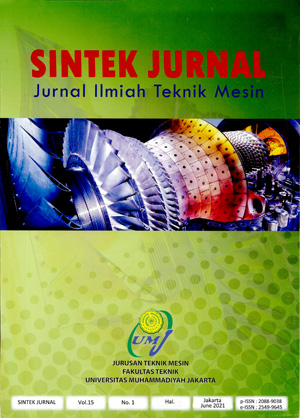THE EFFECT OF SOLUTION HEAT TREATMENT HOLDING TIME VARIATIONS ON THE MECHANICAL PROPERTIES OF ALUMINUM A-6061 BY THE TIG WELDING PROCESS
Main Article Content
Abstract
Article Details
- Articles published in SINTEK JURNAL are licensed under a Creative Commons Attribution-ShareAlike 4.0 International license. You are free to copy, transform, or redistribute articles for any lawful purpose in any medium, provided you give appropriate credit to the original author(s) and SINTEK JURNAL, link to the license, indicate if changes were made, and redistribute any derivative work under the same license.
- Copyright on articles is retained by the respective author(s), without restrictions. A non-exclusive license is granted to SINTEK JURNAL to publish the article and identify itself as its original publisher, along with the commercial right to include the article in a hardcopy issue for sale to libraries and individuals.
- By publishing in SINTEK JURNAL, authors grant any third party the right to use their article to the extent provided by the Creative Commons Attribution-ShareAlike 4.0 International license.
References
C. Natawiguna, N. Muhayat, and T. Triyono, “Pengaruh Solution Heat Treatment terhadap Sifat Fisis dan Mekanik Proses Pengelasan Fssw AA6063-T5,” Mekanika, vol. 17, no. 1, 2018.
A. K. Singh, V. Dey, and R. N. Rai, “Techniques to improveweld penetration in TIG welding (A review),” Mater. Today Proc., vol. 4, no. 2, pp. 1252–1259, 2017.
N. Jeyaprakash, A. Haile, and M. Arunprasath, “The parameters and equipments used in TIG welding: A review,” Int. J. Eng. Sci., vol. 4, no. 2, pp. 11–20, 2015.
A. Naafila, A. Purnowidodo, and P. H. Setyarini, “Pengaruh Waktu Solution Treatment Terhadap Kekuatan Tarik Aluminium Paduan AA 7075-T6,” Pros. SENIATI, pp. 215–220, 2019.
A. Randhiko, G. D. Haryadi, and Y. Umardani, “Pengaruh Post Weld Heat Treatment (Pwht) T6 Pada Aluminium Alloy 6061-O Dan Pengelasan Longitudinal Tungsten Inert Gas Terhadap Sifat Mekanik Dan Struktur Mikro,” J. Tek. Mesin, vol. 2, no. 3, pp. 167–174, 2014.
L. Andewi, “PENGARUH VARIASI ARUS PADA HASIL PENGELASAN TIG (TUNGSTEN INERT GAS) TERHADAP SIFAT FISIS DAN MEKANIS PADA ALUMUNIUM 6061,” 2016.
A. Supandi, “Pengujian Kekuatan Mekanik Hasil Sambungan Las Aluminium 5083 Dengan Metode Las Gtaw (Gas Tungsten Arc Welding),” Apr. 2019.
G. D. Haryadi and H. K. Kustomo, “PENGARUH PENGELASAN TIG FILLER ER 4043 DAN POST-WELD HEAT TREATMENT ALUMINIUM PADUAN TERHADAP SIFAT MEKANIK DAN STRUKTUR MIKRO,” ROTASI, vol. 17, no. 4, p. 189, Oct. 2015, doi: 10.14710/rotasi.17.4.189-196.
D. Maisonnette, M. Suery, D. Nelias, P. Chaudet, and T. Epicier, “Effects of heat treatments on the microstructure and mechanical properties of a 6061 aluminium alloy,” Mater. Sci. Eng. A, vol. 528, no. 6, pp. 2718–2724, 2011.
A. Sastranegara, “Mengenal Uji Tarik dan Sifat-sifat Mekanik Logam,” Situs Inf. Mek. Mater. dan manufaktur, 2009.
N. H. Sari, Material teknik. Deepublish, 2018.


